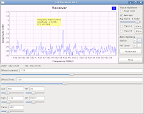I was reading an article in the Danish hamradio magazine about a 1.8 MHz to 70 MHz SDR transceiver. In particular the RF frontend caught my attention because a set of band pass filters and a pre-amp would be a very useful companion for the USRP+LFRX, as would a power amplifier and a set of low pass filters be for the LFTX.
filter
The downsampling experiment
As I mentioned in my previous post, my “optimizations” of the multi-mode receiver code caused a sudden loss in performance.This was a big surprise because what I did was to replace two filters with only one, which I would expected to yield a performance gain and certainly not a loss. What happened at the same time was that the sample rate in the demodulators went from 50 ksps to 250 ksps and it was the responsibility of the demodulators to downsample this to 50 ksps. I suspected that this might have cause the increased CPU load and I have set up a simple experiment to confirm it.
Frequency xlating filter vs. complex multiplication
When I upgraded the simple GNU Radio receiver to single side band, I decided to separate the band pass filter and the frequency xlating filter and the frequency xlating filter got equipped with a wide low pass filter instead. The low pass filter is useful but really not important. Therefore, I decided to replace the frequency xlating filter with a simple complex multiplication (aka. local oscillator) and thereby save some CPU cycles – I figured that removing a filter would save something.
From double side band to single side band reception
 When I presented the Simple CW Receiver few weeks ago I also mentioned and demonstrated that it is actually a double side band receiver (it’s around 2:35 in the video). This is good for AM and FM, but can be very inconvenient for receiving CW and SSB (single side band). If the station we are trying to receive is surrounded by other stations on the neighbouring channels, these will interfere via the opposite side band. Therefore, it was time to look into single side band reception.
When I presented the Simple CW Receiver few weeks ago I also mentioned and demonstrated that it is actually a double side band receiver (it’s around 2:35 in the video). This is good for AM and FM, but can be very inconvenient for receiving CW and SSB (single side band). If the station we are trying to receive is surrounded by other stations on the neighbouring channels, these will interfere via the opposite side band. Therefore, it was time to look into single side band reception.
K1 Filter Realignment
I have played some more with the filter board. I decided not to worry too much about it because the trimmers will be altered again during transmitter alignment, but here are the alignment results so far:
Conclusion on the Filter Alignment
I have tried to use my other dummy load on the FT-817. It did indeed reduce the signal strength in the K1 quite a lot. This may sound a bit strange but it is not. You know, the DL-1 dummy load kit from Elecraft is an open dummy load, meaning that it is not in an enclosure, thus the RF signal is radiated from it. My other dummy load, on the other hand, is built into a piece of cooling metal and looks much more radiation closed than the DL-1 does.
New Attempt on the Filter Alignments
Nice surprise as I came home from work today: The replacement FT37-61 core for the noise blanker has arrived! That was fast. I sent the email on the 2. or 3. got a reply on the 3. and received the new core on the 7. All the way from USA.
K1 Filter Board Alignments
I have hooked up the FT-817 to a dummy load in order to perform the receiver tests on the K1. The first tests consist of aligning the trimmer capacitors on the filter board. To begin with I used the DL-1 dummy load.
Successful Filter Board Tests
After completing the assembly of the K1 filter board, I have done the resistance checks on the board. All checks tests passed perfectly 🙂 The next step will be to proceed with the tests of the RF board and then the combined tests and alignments of the RF + filter boards, which in fact is … Read more
Coils for the Filter Board
I have just finished mounting the coils onto the K1 filter board. It turned out that some transformers need their secondary to interleave with the primary, on the contrary to what I mentioned earlier. I guess it depends on the function of the transformer.